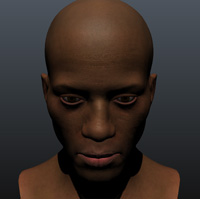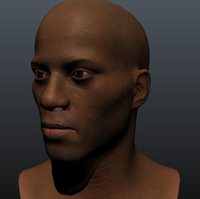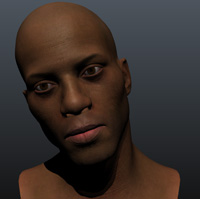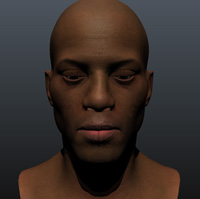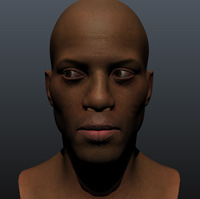FaceFX Support
FaceFX Documentation and support
Default Character Setup
Table of Contents
Setup your character with the following poses on the following frames for the default setup. You do not need to create them all. The FBX Pipeline will ignore frames that are not keyed.
If you need to customize your setup, that’s fine too. It’s easy to add targets, just key them and record the names and frame numbers in the Batch Export Text File. Changing the Mouth Targets or Tongue Targets will require that you change the Default Mapping for your character.
Rest Pose (frame 0)
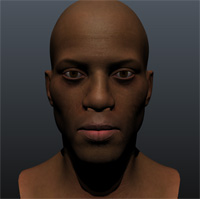 The Rest Pose is always on frame 0. A neutral expression is on the face, the eyes are open and looking forward. The Rest Pose is important, because all bone poses are relative to it. By comparing the bones that have moved from the Rest Pose, all other bone poses are created. The Rest Pose can be the same as your bind pose, but it doesn’t have to be. No morphs should be active in the Rest Pose.
The Rest Pose is always on frame 0. A neutral expression is on the face, the eyes are open and looking forward. The Rest Pose is important, because all bone poses are relative to it. By comparing the bones that have moved from the Rest Pose, all other bone poses are created. The Rest Pose can be the same as your bind pose, but it doesn’t have to be. No morphs should be active in the Rest Pose.
6 Mouth Targets
open - frame 10
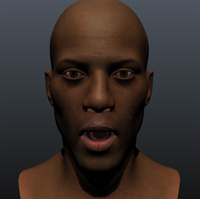 open is the jaw-open meta-target. The jaw is opened and the corners of the mouth drop slightly. Open the jaw wide since the Default Mapping never drives this pose much more than 50%.
open is the jaw-open meta-target. The jaw is opened and the corners of the mouth drop slightly. Open the jaw wide since the Default Mapping never drives this pose much more than 50%.
W - frame 20
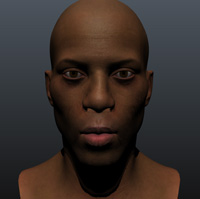 The W target makes the mouth look like it is whistling. The jaw is opened slightly. The upper lips are pulled down to cover the teeth. In the Default Mapping, this pose is important because it is used to round the mouth in vowels like when you say “bOOt”.
The W target makes the mouth look like it is whistling. The jaw is opened slightly. The upper lips are pulled down to cover the teeth. In the Default Mapping, this pose is important because it is used to round the mouth in vowels like when you say “bOOt”.
ShCh - frame 30
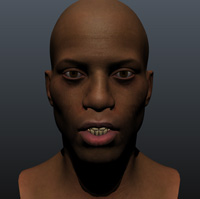 The ShCh target is used to make the mouth look like it is saying “Shhh”. The upper and lower teeth should just touch and the lips are pursed to show the teeth. In the Default Mapping, this pose is important because it is also used to make the mouth form the “ER” sound like in “fevER”.
The ShCh target is used to make the mouth look like it is saying “Shhh”. The upper and lower teeth should just touch and the lips are pursed to show the teeth. In the Default Mapping, this pose is important because it is also used to make the mouth form the “ER” sound like in “fevER”.
PBM - frame 40
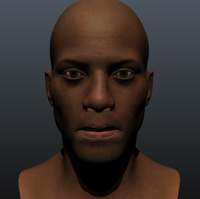 The PBM target pushes the lips together completely to form a seal. If desired, the upper and lower lips can curl inwards (in a bone rig, some rotation may be used). The jaw can be opened just slightly behind the lips.
The PBM target pushes the lips together completely to form a seal. If desired, the upper and lower lips can curl inwards (in a bone rig, some rotation may be used). The jaw can be opened just slightly behind the lips.
FV - frame 50
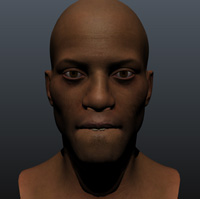 The FV target tucks the lower lip behind the upper teeth. The jaw is opened slightly. The upper teeth are exposed by moving the upper lip slightly.
The FV target tucks the lower lip behind the upper teeth. The jaw is opened slightly. The upper teeth are exposed by moving the upper lip slightly.
wide - frame 60
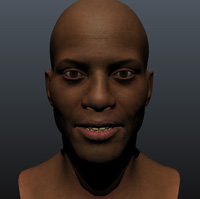 The wide target brings the upper lip up slightly and the corners of the mouth out. No jaw movement is required. When combined with a little bit of the open target, the wide target creates the “EE” sound in “tree” or “beet”. Moving the tongue to the roof of the mouth creates the “S” and “Z” sounds. Wide is also used as a component in many of the vowel targets to expose the upper teeth and widen the mouth. The wide target is used frequently in the default mapping, so be careful that it is not overly exaggerated.
The wide target brings the upper lip up slightly and the corners of the mouth out. No jaw movement is required. When combined with a little bit of the open target, the wide target creates the “EE” sound in “tree” or “beet”. Moving the tongue to the roof of the mouth creates the “S” and “Z” sounds. Wide is also used as a component in many of the vowel targets to expose the upper teeth and widen the mouth. The wide target is used frequently in the default mapping, so be careful that it is not overly exaggerated.
3 Tongue Targets
The below tongue targets are not required, but if your character has a tongue, they can be used. The jaw should not move (the teeth below are shown for reference only). Only the tongue should move.
tBack - frame 70
 The tBack target moves the back of the tongue to the back of the mouth for making the “K” or “G” sound. Remember that the target should not include any jaw movement (unlike the picture shown to the left).
The tBack target moves the back of the tongue to the back of the mouth for making the “K” or “G” sound. Remember that the target should not include any jaw movement (unlike the picture shown to the left).
tRoof - frame 80
 The tRoof target moves the tip of the tongue to the roof of the mouth for making the “T”, “D”, “N”, and “L” sounds. Remember that the target should not include any jaw movement (unlike the picture shown to the left).
The tRoof target moves the tip of the tongue to the roof of the mouth for making the “T”, “D”, “N”, and “L” sounds. Remember that the target should not include any jaw movement (unlike the picture shown to the left).
tTeeth - frame 90
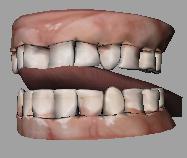 The tTeeth target brings the tip of the tongue in front of the upper teeth for making the “Th” sound. Remember that the target should not include any jaw movement (unlike the picture shown to the left).
The tTeeth target brings the tip of the tongue in front of the upper teeth for making the “Th” sound. Remember that the target should not include any jaw movement (unlike the picture shown to the left).
3 Gesture Targets
Blink- frame 100
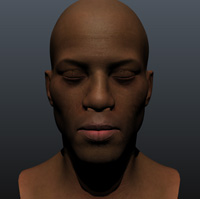 The upper lids close down to the lower lids. Make sure only the lids move relative to the rest pose at frame 0!
The upper lids close down to the lower lids. Make sure only the lids move relative to the rest pose at frame 0!
Eyebrow Raise - frame 110
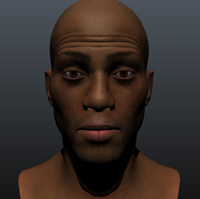 The eyebrows go up evenly. The character looks interested, not confused or angry. Make sure only the eyebrows move relative to the rest pose at frame 0!
The eyebrows go up evenly. The character looks interested, not confused or angry. Make sure only the eyebrows move relative to the rest pose at frame 0!
Squint - frame 120
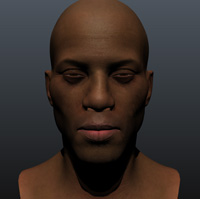 The lower eyelids go up to the pupils. The upper eyelids can come down slightly. Make sure only the eyelids move relative to the rest pose at frame 0!
The lower eyelids go up to the pupils. The upper eyelids can come down slightly. Make sure only the eyelids move relative to the rest pose at frame 0!
8 Rotation Targets
All rotations are assumed to be 30 degrees.
Head_Pitch_Pos- frame 130
Head_Yaw_Pos- frame 140
Head_Roll_Pos- frame 150
Eyes_Pitch_Pos - frame 160
Eyes_Yaw_Pos - frame 170
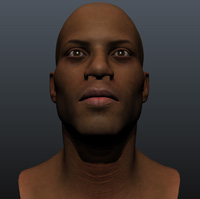
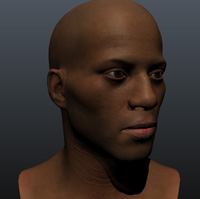
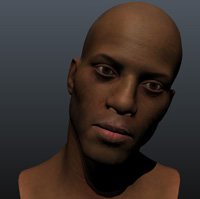
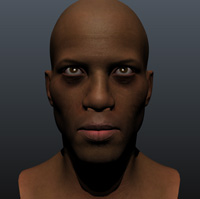
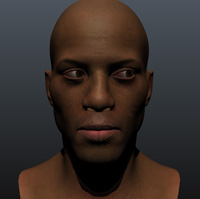
Head_Pitch_Neg - frame 180
Head_Yaw_Neg- frame 190
Head_Roll_Neg- frame 200
Eyes_Pitch_Neg - frame 210
Eyes_Yaw_Neg - frame 220
